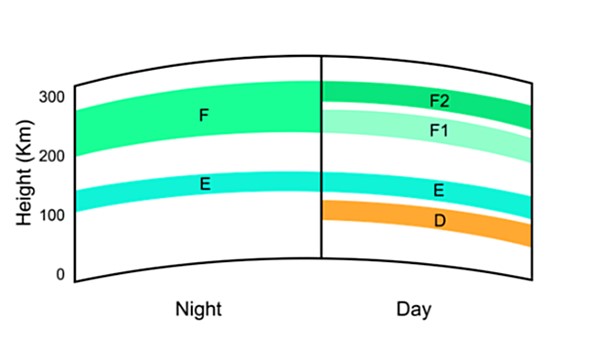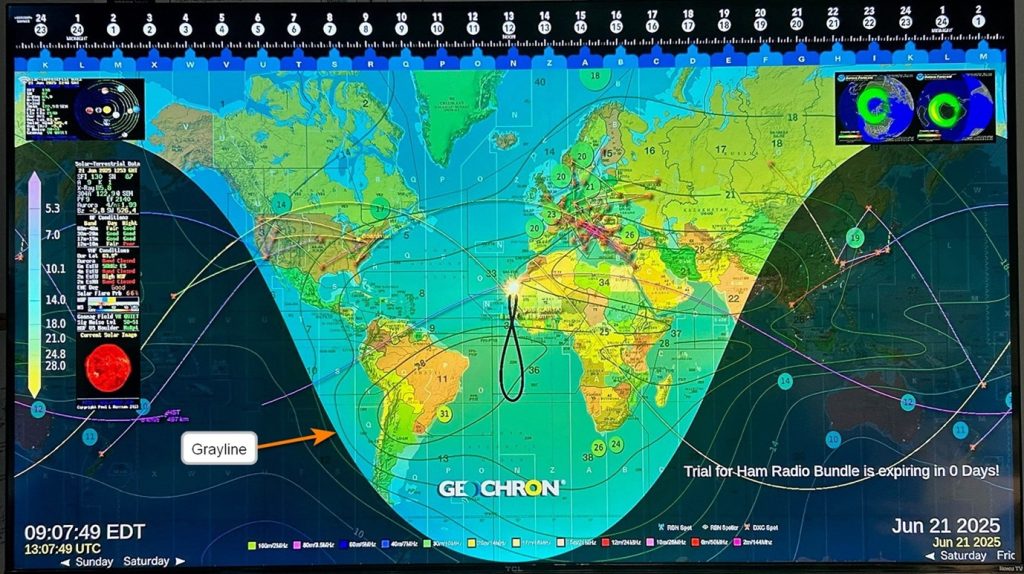Imagine for a moment that you’re sitting in your ham shack, coffee in one hand and microphone in the other. It’s either just before sunrise or just after sunset, and suddenly—boom!—you’re talking to someone halfway around the world who sounds like he’s right next to you. No sunspots, no fancy beam antenna, no EME wizardry.
What just happened? Welcome to the weird and wonderful world of gray line propagation—also known as the magical twilight zone of HF radio. Before we travel this middle ground between light and shadow, let’s start with a quick review of the ionosphere.
The Ionosphere: Nature’s Bouncer
Your HF signals generally don’t travel in straight lines to faraway lands—they bounce. And they don’t bounce off clouds or car-sized drones. They bounce off the ionosphere, a high layer of Earth’s atmosphere charged with solar radiation. Think of the ionosphere as a bouncer at the exclusive club called DX Planet. During the day, it’s all lit up and active with layers named D, E, and F. At night, the scene changes. Some layers disappear while others chill out, and the bouncer’s attitude shifts from “get lost” to “come on in.”
Most of the time, HF propagation is a battle between you, the sun, and the ionosphere’s charges. But twice a day, during dawn and dusk, all the rules change—and that’s where gray line propagation comes into play.
What Is Gray Line?
The gray line represents the band of twilight that surrounds the Earth at sunrise and sunset. It’s not quite night, not quite day. Just enough light to find your car keys but not enough to see the puddle you’re about to step in.
In radio terms, the gray line is a narrow corridor of enhanced propagation that follows this twilight zone. When your QTH is in the gray line and your target station is also in the gray line—boom! The ionosphere enters a cooperative state, allowing long-distance communication with remarkably low power and minimal QRM.

Why It Works: A Tale of Two Ionospheres
Let’s go back to D, E, and F for a moment.
During the day, the ionosphere’s D layer is strong and active. And like SpongeBob absorbs water, it loves to absorb your HF signals—especially the lower bands such as 160, 80, and 40 meters. These signals don’t bounce; they die. But when night falls, the D layer quickly dissipates, the E layer’s refraction becomes weaker, and the ionosphere is left in the hands of the F layers. F1 and F2 combine into a single F layer, which is much more accommodating for bouncing signals around the planet.
In the gray line, you’re at the perfect handoff point. The D layer is disappearing, but the F layer is still energized—hello long-distance skip! This sweet spot gives signals a temporary pass to skip much farther than usual—think thousands of miles. It’s as if the Earth is saying, “Hey, for the next 45 minutes, let’s open up those bands.”
Timing is Everything
So, when should you fire up your transceiver? Gray line propagation lasts just a short time—roughly 30 to 60 minutes—during local sunrise and sunset. But here’s the kicker: It works best when both you and the distant station are in the gray line at the same time. It’s like speed dating. You’ve got a narrow window to meet your DX contact, so don’t be late.
Want to talk to New Zealand from New York on 40 meters with 10 watts? Try doing it when both cities are bathed in twilight. You’ll sound like you’re across town instead of across the globe. Of course, if you miss the window, you’re back to shouting into the ether. Can you hear me now?
What Bands Rock the Gray Line?
Glad you asked. Radio waves, particularly on lower bands like 160 meters, can travel long distances along the gray line due to reduced signal absorption in the D layer of the ionosphere:
- 160 meters (Top Band) lives for the gray line. Signals that typically vanish into the noise floor suddenly soar across continents.
- 80 and 40 meters are also fantastic. Many seasoned DXers get their best contacts on 40 meters during gray line hours.
- 30 meters: Low absorption and strong F-layer reflection during gray line can produce long-distance contacts on 30 meters, sometimes even across the globe.
- 20 meters occasionally benefits, especially during low sunspot periods.
- Higher bands (15, 12, 10 meters)—not so much. These tend to thrive during peak daylight, when the ionosphere is fully ionized.
Bands below 30 meters (10 MHz) are perfect for exploring gray line propagation and making exciting DX contacts, especially if you’re targeting north-south paths during the dawn and dusk hours.
DXers’ Dirty Secret
Veteran DXers don’t just hope for propagation—they hunt gray line like Sarah Connor hunts Terminators. They keep maps of the Earth’s terminator (the line between day and night), check solar data, and set alarms for sunrise in exotic countries. While you’re hitting the snooze button, they’re snagging a QSO with Bhutan.
There’s even software and apps that help you visualize where the gray line is at any given time, and, of course, there’s the Geochron Digital Atlas 2 4K display. If you want to impress your ham buddies, casually mention that you’re timing your 40-meter net check-in with the solar terminator over Mongolia. You’ll either get admiring nods or perplexed looks.

It’s Addictive
The thrill of gray line DX is real. You start off chasing a VK station at dawn. Next thing you know, you’re setting alarms for 5 am every day, drinking extra-large cups of coffee, and telling your XYL you need “just five more minutes” on the radio. It’s like the fishing trip that never ends, only your bait is a dipole, and your catch speaks Portuguese.
The Magic Hour
Gray line propagation is one of the most fascinating and rewarding phenomena in amateur radio. It takes timing, a bit of knowledge, and a lot of curiosity, but the payoff is huge. It’s one of those things that reminds us why we got into ham radio in the first place: the thrill of reaching out across the world, with nothing but the sky to help us. And who knows? That next QSO might just be your best one yet.
So tomorrow morning, grab your rig, tune to 40 meters, and give it a shot. The world might be asleep, but the gray line is wide awake and waiting—today and tomorrow.

